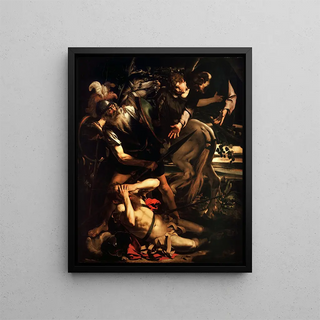Art print | The Conversion of Saint Paul - Caravaggio


View from behind

Frame (optional)
In the fascinating world of baroque art, "The Conversion of Saint Paul" stands as an iconic masterpiece by Caravaggio, a painter whose genius defined an era. This artwork, depicting the decisive moment when Saul, the persecutor of Christians, is struck by divine light on the road to Damascus, embodies unparalleled dramatic intensity and spiritual depth. Caravaggio, master of light and shadow, manages to capture not only the precise instant of revelation but also the raw emotion emanating from it. Viewing this art print transports you to a scene where the sacred and the profane meet, where the spiritual transformation of man reveals itself in all its power.
Style and uniqueness of the work
The piece is distinguished by its bold use of chiaroscuro, a characteristic technique of Caravaggio, which enhances the contrast between light and darkness. This approach creates an almost theatrical atmosphere, highlighting the figures while immersing the rest of the composition in a mysterious gloom. The faces of the characters, marked by intense expressions, reveal palpable humanity, each gaze filled with surprise and awe. The dynamic between the characters is also captivating, with the palpable tension between the angel and Saul reflecting the shock of divine revelation. The staging, both realistic and symbolic, invites viewers to reflect on their own spirituality, making this work strikingly modern despite its age.
The artist and his influence
Michelangelo Merisi da Caravaggio, best known as Caravaggio, is an essential figure in art history. Born in Milan at the end of the 16th century, he revolutionized painting with his innovative approach that blends realism and drama. His influence extends far beyond his time, inspiring generations of artists across Europe. Caravaggio was able to capture the very essence of humanity, transforming biblical scenes into profoundly human stories. His impact is evident in the work of many baroque painters, who have

Matte finish

View from behind

Frame (optional)
In the fascinating world of baroque art, "The Conversion of Saint Paul" stands as an iconic masterpiece by Caravaggio, a painter whose genius defined an era. This artwork, depicting the decisive moment when Saul, the persecutor of Christians, is struck by divine light on the road to Damascus, embodies unparalleled dramatic intensity and spiritual depth. Caravaggio, master of light and shadow, manages to capture not only the precise instant of revelation but also the raw emotion emanating from it. Viewing this art print transports you to a scene where the sacred and the profane meet, where the spiritual transformation of man reveals itself in all its power.
Style and uniqueness of the work
The piece is distinguished by its bold use of chiaroscuro, a characteristic technique of Caravaggio, which enhances the contrast between light and darkness. This approach creates an almost theatrical atmosphere, highlighting the figures while immersing the rest of the composition in a mysterious gloom. The faces of the characters, marked by intense expressions, reveal palpable humanity, each gaze filled with surprise and awe. The dynamic between the characters is also captivating, with the palpable tension between the angel and Saul reflecting the shock of divine revelation. The staging, both realistic and symbolic, invites viewers to reflect on their own spirituality, making this work strikingly modern despite its age.
The artist and his influence
Michelangelo Merisi da Caravaggio, best known as Caravaggio, is an essential figure in art history. Born in Milan at the end of the 16th century, he revolutionized painting with his innovative approach that blends realism and drama. His influence extends far beyond his time, inspiring generations of artists across Europe. Caravaggio was able to capture the very essence of humanity, transforming biblical scenes into profoundly human stories. His impact is evident in the work of many baroque painters, who have






